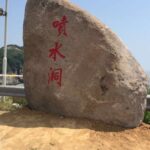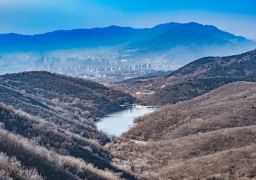The wooden arch covered bridges in Qingyuan not only have the characteristics of large quantity, long history and continuous historical evolution across the country, but also the existing wooden arch covered bridges with long lifespan, large arch span and long length in the country are all located in Qingyuan. Among them, the four well-known ancient bridges are: Yonggui Bridge in Gucheng Town, Yuqiao and Lanxi Bridge in Wudapu Township, and Houkeng Bridge in Zhukou Town. All of them are large-span cantilevered wooden arch bridges. With a long history, unique structure, beautiful shape and national characteristics, they have occupied a place in the history of Chinese bridges.
Yonggui Bridge: Located in the north of Songyuan Town in the county, on the back of a stone turtle. It is currently a county-level cultural relic protection unit. The bridge has forty-one bays and is dozens of zhang long. It has a unique shape and is named ‘Yonggui Bridge’. The bridge name comes from the sentence in ‘The Analects of Confucius. Advanced’: ‘Bathing in the Yi River, enjoying the breeze at Wuyu, and chanting on the way back’. Since the construction of Yonggui Bridge more than 500 years ago, it has experienced floods and fires and has been rebuilt several times. By the time of liberation, only the left bridge from the south bank to the stone turtle remained. Yonggui Bridge is a wooden cantilevered arch bridge. Large fir trees are used to build a’magpie nest’, forming a bow-shaped wooden arch bridge. No iron nails are used in the wooden arch. It spans over Qiushan and the stone turtle. The bridge deck is paved with stones and is flat and firm. Corridor houses are built on the bridge and covered with rafters and tiles. The bridge eaves slightly extend towards the river surface with wind and rain plank walls. Benches are set up between the two rows of pillars and railings. Tourists can rest on them and enjoy the nearby mountains and distant peaks, and watch fish swimming and ducks playing. At the north end of the bridge is a two-story building named ‘Butian Pavilion’. In the past, there was a statue of a woman waiting with fluttering clothes. Looking into the distance from the pavilion has its own charm. Houkeng Bridge: Located 16.6 kilometers northwest of the county seat, in the north of Zhukou Village. It was first built in 1671 (the tenth year of Kangxi in the Qing Dynasty) and renovated in 1885 (the eleventh year of Guangxu). It is 36 meters long and 5 meters wide. It is a wooden arch structure with corridor pillars and tiled roof. Simple and elegant. It is a county-level cultural relic protection unit. Yuqiao: Located on Mengzhou Creek 8 kilometers east of the city. It was first built in the Yuan Dynasty (1335, 1340), and was rebuilt many times after being destroyed. The existing bridge was rebuilt in 1898 (the twenty-fourth year of Guangxu in the Qing Dynasty). It is a covered bridge with a wooden arch and cantilever. It is 36 meters long and 5 meters wide. It is currently a county-level cultural relic protection unit.Qingyuan Ancient Bridges
The wooden arch covered bridges in Qingyuan not only have the characteristics of large quantity, lon[...]









